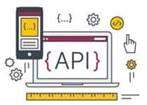The concern, however, gets more pronounced when dealing with healthcare technologies. It is important to understand that some users may have physical disabilities and need special assistance. The design, therefore, should include features that aid them when interacting with healthcare products and services. For example, having a built-in screen reader can help users with hearing disabilities.

Rather than tackling these challenges in silos, what if we intertwined the brightest spots from multiple disciplines? So UX designers have a difficult problem in creating data representations, understandable to persons without medical training. UX design can help simplify the interface of HIT systems, making them simpler to use and straightforward, thereby decreasing the cognitive strain on healthcare practitioners. Moreover, feedback from healthcare experts can help UX designers pinpoint problems and develop effective solutions.
Smooth Data Visualization
Regularly collecting feedback from healthcare providers and patients is essential if we want to make sure that our designs meet their needs. At the heart of design thinking (also widely known as human-centered design) lies a profound respect for the human experience. It’s not merely about coming up with solutions; it’s about understanding the people for whom these solutions are intended. By prioritizing empathy, design thinking champions the notion that truly transformative solutions arise when we connect with the emotions, needs, and aspirations of the end-users.

Effective collaboration between medtech professionals and designers could have far-reaching impacts across the industry. For instance, in collaboration with a medtech team, our design team created a UI for a device that counts sponges after operations. Nurses simply point the device at buckets that hold surgical waste and the device counts sponges in them in a matter of seconds. If the total is off, nurses will count the wasted sponges manually, and the device can be used to find a sponge left in the patient’s body. Previously, counting sponges was an entirely manual process, consuming precious time and attention. But operating this device takes seconds and requires no specialized training.
Stories to Help You Grow as a Designer
As a result, we’ve created user personas that accurately reflect the pains and needs of the audience that a brand-new healthcare platform should tackle. Before heading into the medical UX design, we’d like to explain the role of user experience design in healthcare and summarize the current state of UX in healthcare. In this article, our chief design officer Daria shares how we created custom healthcare UX design solutions for companies in the USA and Germany and lists the peculiarities of designing for the healthcare industry. The COVID-19 pandemic resulted in a higher global demand for digital healthcare services. Telehealth’s total annual revenues grew 83% in 2021 compared to 2019, according to the report by McKinsey. Utilize white space effectively to balance out all the visual elements for an impressive and crisp look and feel.

In this piece, we’ll examine some of the most pressing healthcare UX issues. First, however, let’s go further into why UX is so crucial in the healthcare industry. The NHS is a case study in how cutting-edge artificial intelligence tools can be harnessed by public health systems across the world. Here’s a brief look into how innovators and entrepreneurs are capitalizing on generative AI to empower healthcare delivery in 2023. You’re a healthcare professional with an idea or health care tech founder in need of expert help – find out more.
UX research is a must
The main problems include complex processes, user-friendly interfaces, regulatory compliance, accessibility, data visualization, and emotional sensitivity. We also offer summative usability testing to verify and validate your solutions as having met FDA requirements and regulations. This enables us to produce user experiences and designs that comply with safety regulations set by the government, which is especially important in the healthcare industry. Prototypes are essential for building a flawless user experience in any industry and they are often used to perform formative usability testing. They also hasten the design process because they help in assessing UI/UX designs and validating them before any actual development occurs.
- Vocal biomarkers are medical signs deducted from the features of your voice.
- It has long been noted that the healthcare industry is among the slowest to adopt new technology and digitalization.
- While there are several use cases to be covered in the design, the UI must facilitate a smooth and hassle-free experience for the users.
- He has worked as a product manager and UX director on innovative projects such as the phone repair service iCracked (acquired by Allstate) and a pill management device later acquired by Stanley Black & Decker.
- Augmented Reality (AR) can show extra information on the digital device in addition to the real world with which it can pioneer surgical planning or diagnostics.
- What follows is a discussion on the importance of healthcare experience design and some of the key concerns for UI/UX designers.
- For elderly patients who might not be very familiar with technology, providing hints and tips helps them to use the apps effectively and carry out their day-to-day tasks without assistance.
These are just a few examples of how unoptimized technologies can prevent people from meeting their needs. At Limeup, we stress the importance of taking into account the needs of the elderly when designing UX healthcare solutions. Our UX team has worked with an American medical startup, Raccoon Recovery, to design and develop a custom software solution to help patients with injuries recover faster.
What’s the Point of AI without Design and Systems Thinking?
Healthcare UX refers to the design of the user experience of any healthcare product or service, such as electronic health records, disease management apps or doctor appointment scheduling apps. Prioritizing user-centric features is crucial, and should consider both patients’ and doctors’ profiles. The telehealth market size was valued at USD 43.5 billion in 2022 and is expected to increase by 11.6% annually in this decade. To provide a seamless and engaging user experience to patients and healthcare providers, it is necessary to invest in good UI/UX to enhance the overall experience and increase user engagement. The firm provides web development, custom software development, ux/ui design, digital strategy, and more, and is small.

The design, therefore, should not be difficult to interact with to ensure safety and better accessibility. The value of services provided by a UI/UX designer or a healthcare UX design agency cannot be overstated in the digital world. For all healthcare organizations of today, it is essential to give due attention to UI/UX design.
Virtual and Augmented Reality
Lack of it can cost a company financial penalties, legal problems, and extra headaches. Only 22% of EHR-integrated apps support FHIR, the industry-wide interoperability standard machine learning and ai for data exchange. A more recent major project includes the modernization of a healthcare app for a global manufacturer of diagnostic imaging and radiopharmaceutical products.
People over 60 are expected to make up as much as 23.5% of the population by 2060 in the US. Many age-related factors affect older people’s abilities to use websites, apps and digital products. This means making features like text size options, color variations, simple navigation, etc.
Healthcare UX Design
Areteworks’ research team has significant experience gathering and comprehending stakeholder feedback to improve user experiences. Our research methodologies include face-to-face and remote user interviews and observations. We also leverage secondary research and our extensive healthcare industry knowledge to identify and define primary user needs. Our empathetic approach to research allows us to provide valuable insights that improve healthcare outcomes for all stakeholders. No matter which of the above-mentioned areas your product or service is focusing on, a good user experience is essential for its success and integrity in improving the well-being of people.
The usability problem with prompt-driven AI
Over time, we have worked with a number of global medical organizations among which Fortune 100 companies. Limeup is a UX design and software development company that works with startups and enterprises worldwide. At Limeup, we have a team of 40+ UX designers, researchers, and developers ready to create custom solutions that meet the needs of your target audience and your business goals. According to McKinsey & Company, the growth in telehealth usage peaked at the beginning of the pandemic outbreak because patients and providers sought ways to safely access and deliver healthcare. Healthcare companies and medical institutions worldwide were reluctant to go digital before the acute outbreak in March 2020. The common doctor-patient relationships were based on personal interaction.
Exploring Innovative Approaches to User Experience
This infographic illustrates some of the primary UX design considerations for medical products. By taking these factors into account, designers can ensure that medical products are safe, accessible, and meet users’ needs. Applying healthcare UX to even more medical procedures and products will multiply its impact and create better health outcomes for more people. For example, an insulin pump that monitors blood sugar levels and delivers insulin automatically became available in 2019. Despite the device being a significant technological development, nearly a fifth of its early adopters stopped using it within months.


